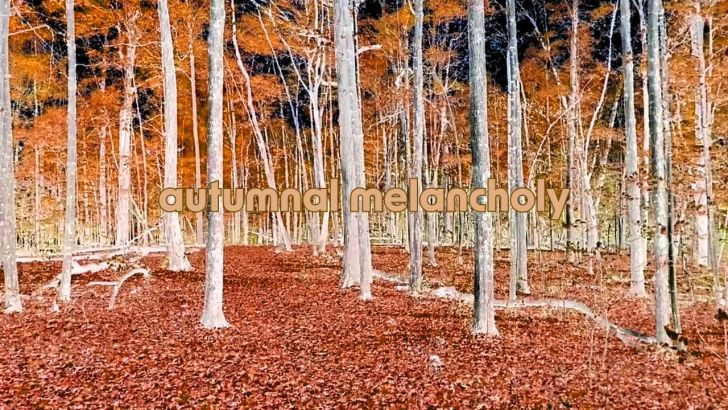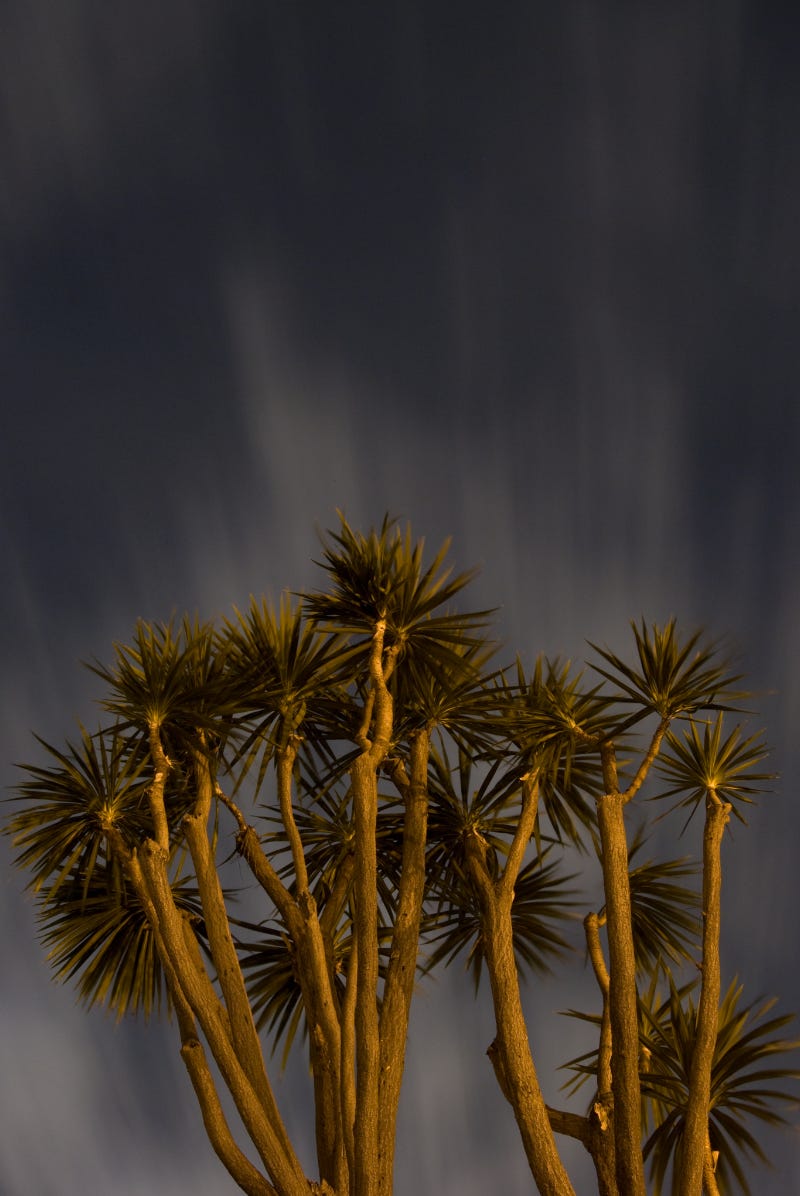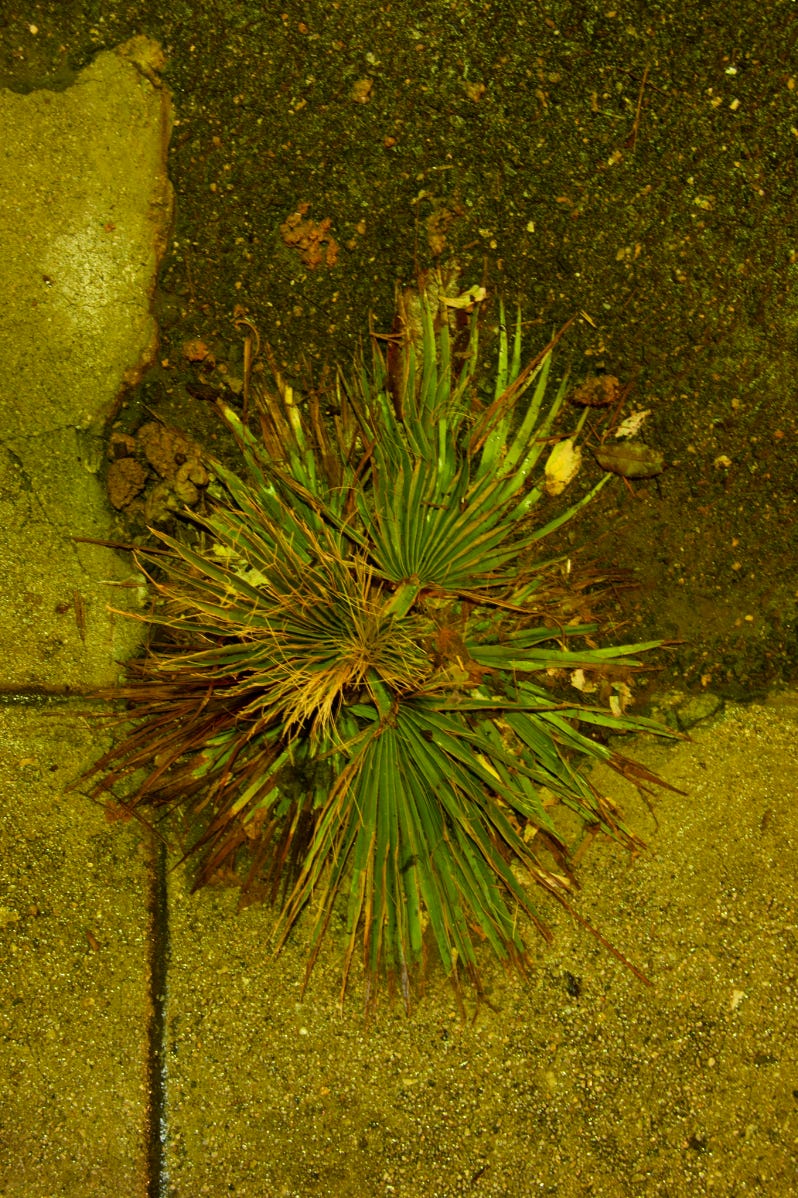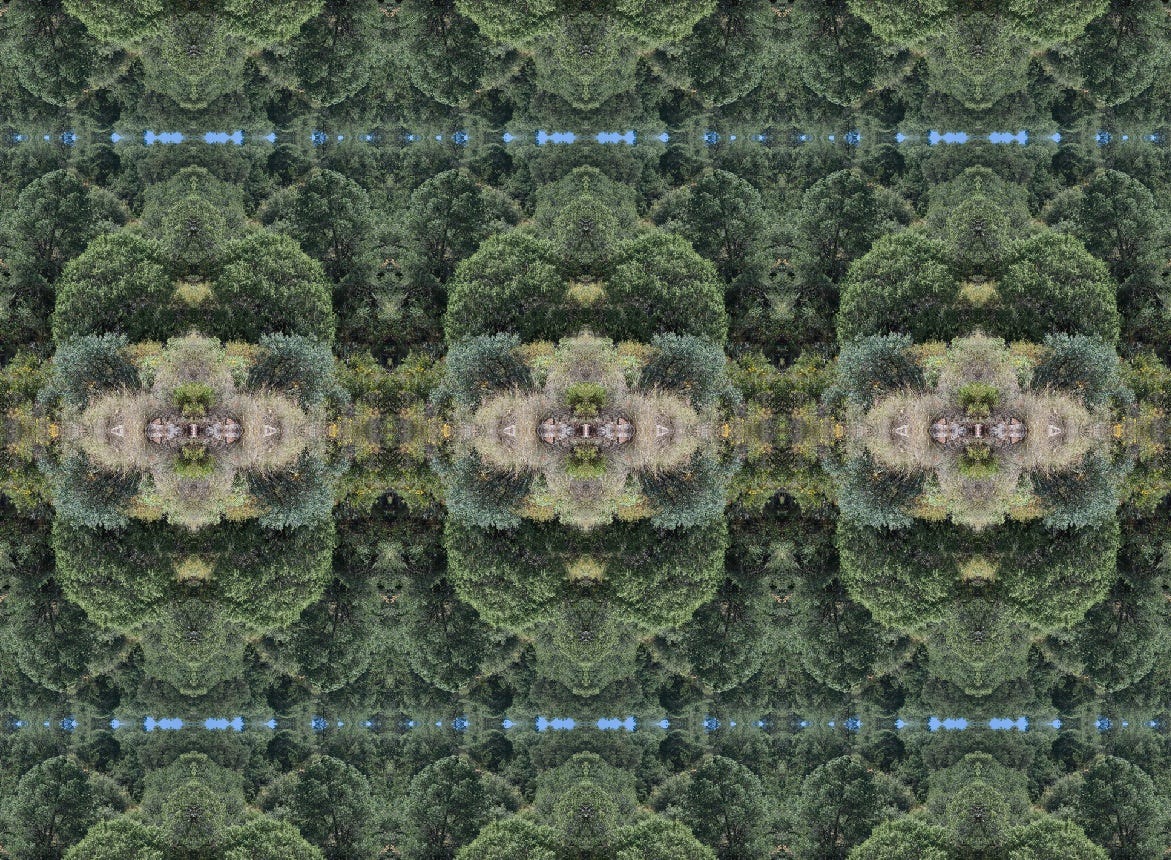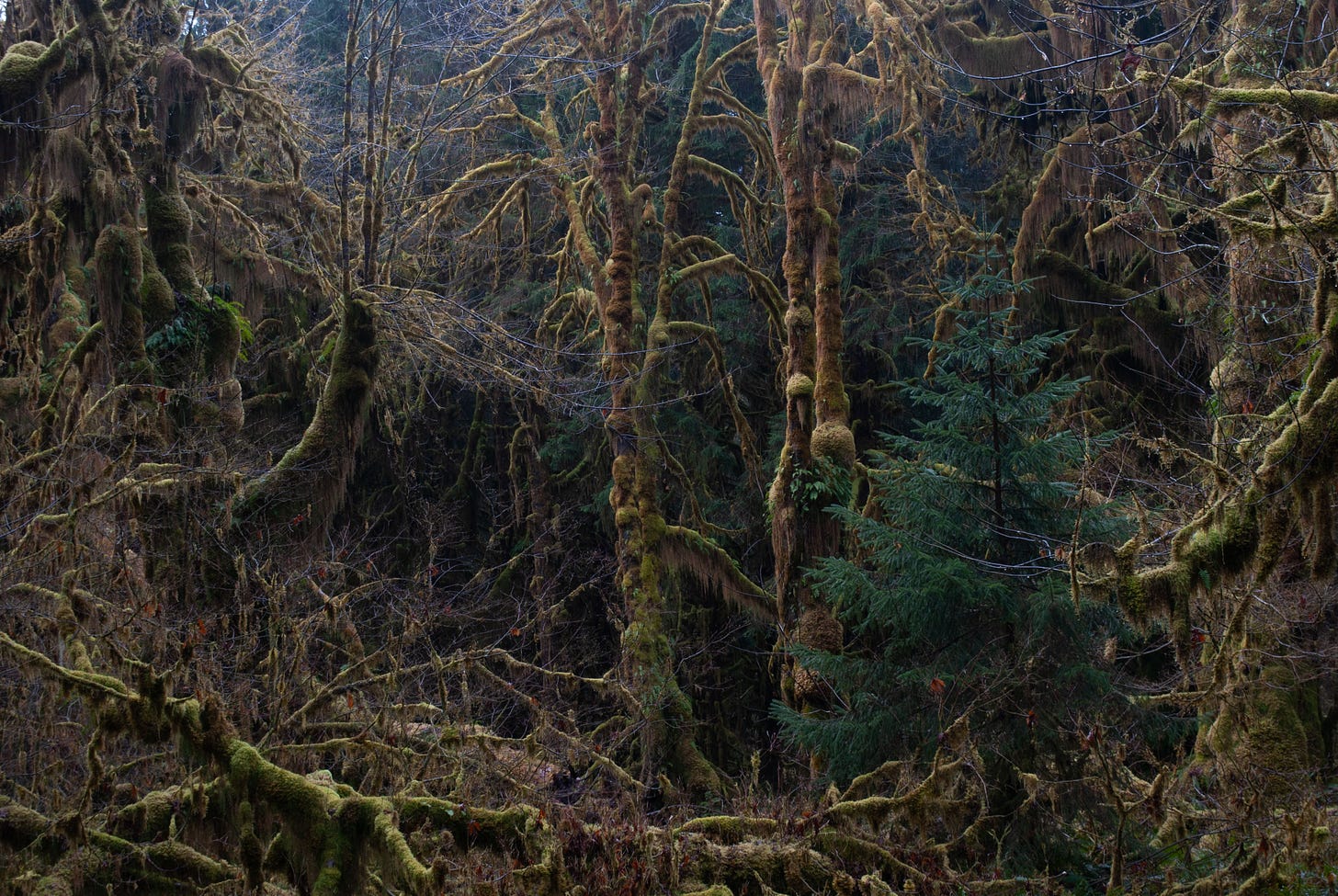Scraps of Old Growth
An Autumnal Melancholy photo digest to accompany our annual mix series of bummer ambient, goth dub, and rotting crust
header video: untitled (inverted and oversaturated slow motion footage from White River Woods in Selma, Indiana) 2022 | Daniel Chamberlin
As an experiment, I recorded an audio version of this newsletter that you can find up above. In addition to my voice, it includes music and field recordings from Irv Teibel, Katherine Rae Mondo, Crystal Chimes, seedspore, and The Pioneers.
Is this a podcast now? What do you think?
When I first started making visual art in the late ‘00s, I was thinking very stoned thoughts about the ecological ideas in Frank Herbert’s Dune. I was trying to explode patches of Los Angeles’ urban green space into something monumental, and later I aspired to the virtual greening of arid lands using the Chihuahuan Desert as a stand-in for Arrakis. I’m still figuring out how those ideas relate to the things I’ve been making since returning to the Midwest in 2016.
Find the corresponding Inter-Dimensional Music: Autumnal Melancholy mixes in the previous issue of Void Contemplation Tactics:
In 2008 I lived in Los Angeles and spent a lot of time moseying around in urban green spaces like the LA River, or the well-trodden trails of the Angeles National Forest. In order to try and distinguish my photos as something other than nice pictures of the trees in my neighborhood, I started doing long exposure night photography. The idea was something to do with finding transcendent or uncanny aspects of otherwise mundane plant life, a visual representation of temporal accumulation1, and maybe some kind of critique of light pollution. I wandered around Atwater Village and Mt. Washington at night like a creep with my entry-level DSLR and a hefty tripod, and made a bunch of photos looking up into the urban canopy, or made a kind of micro-scale version of aerial photography of grubby shoots pushing up through the concrete. The result was a small contribution to a 2008 student group show in the hallway of an ArtCenter College of Design annex: Artificial Night Lighting and Photosynthetic Organisms. You can find the original images from the exhibition on my portfolio site. I was digging around in the archives recently and found a few outtakes that I still really enjoy:
When I left Los Angeles for Marfa and Far West Texas in 2009, I set out to do more of the same thing. But the Big Bend is spread out under some of the darkest skies2 in the United States. The battle against light pollution was less of a concern. Instead I focused on the colonies of botanical organisms that lived among the various geological conglomerations and drifting mounds of mineral particles. This arid land immersion was also an opportunity to expand my understanding of old growth: In the desert, the oldest plants are not always the largest plants. And so I began propagating this resilient botanical life – intentionally looking for non-monumental perspectives – through duplication and rotation into so-called “sacred geometries.” Appropriating the oblique strategy “repetition is a form of change" for Fremen ends. You can find several collections of these “Ecstatic Camouflage” works on my portfolio site at danielchamberlin.com.


Many people think of towering Sequioa sempervirens or the murky moss-draped biomass of the Hoh Rainforest when the term old growth comes up. And while these are extraordinary and ancient deep forest environments that I have enjoyed exploring, they have been documented at length by far more accomplished artists and scientists using much better equipment than my clunky old DSLR.
In 2010 I started exploring “Old Growth in the East” on trips back and forth between Far West Texas and the Midwest. A friend once referred to these isolated groves as “lesser cathedrals” that were no less holy despite their humble appearance. Old growth forests are valuable because of the age of relationships between a broad community of organisms, not only because of their most grandiose members. The once obscure concept of “forest-bathing” is one way to illustrate this community. Old growth air has unique properties as the product of the trees, their photosynthetic cousins in the forest soil, the understory, and canopy. It is also mixed with the breath, spores, dander, and other secretions of birds, mammals, bacteria, and fungi. The forest is a small scale hyperobject, an inconceivable culmination of these fluid relationships that change and develop over time – changes and effects that are durational and cumulative – as part of a living ecosystem. But as I would soon discover after returning to the Midwest, the problem with old growth in the east isn’t about the height or girth of the trees, but the limitations imposed on the community’s boundaries. Still, as Joan Maloof – founder of the Old-Growth Forest Network – writes in Teaching The Trees as she prepares to visit a small patch of protected woodland,
“Twenty acres can barely be called a forest, but still I was anxious to see this unique scrap.”
The old growth forests I’ve spent time with here in Indiana are indeed scraps. Although I’ve come to think of them more as memorials. They’re usually surrounded by endless industrial agricultural wastelands, a denuded landscape interrupted only by tiny pioneer cemeteries and private nature preserves. Both are instances of sacred ground where the inconceivably vast histories of the former inhabitants are interred, slowly turning back to soil.
There’s something ominous about the private nature of these shrines, regardless of their keeper’s benevolent intentions. Despite the cheery tone affected when thanking the patrons who have decided that a corner lot of woodland is this year’s way to dodge taxes. They represent a dystopian libertarian reality where the only land that is preserved is that which is the least profitable in terms of resources to be extracted.
It’s a stark contrast with the public lands that I came to take for granted in California and New Mexico, or the sprawling wilderness parks of the Texas/Mexico borderlands. These Western zones are less widely known, and far less traveled, than most state or national parks. I’m thinking of the time I did a solo backpacking trip to an untraveled National Forest district in Southeastern New Mexico: I called the ranger station beforehand to inquire about the viability of springs along my route, and they warned me that they were unreliable, as I expected. Driving through the charred wastes to my trailhead a few days later, it became apparent that the rangers I spoke with were unaware that this section of forest had mostly burned down the previous year. There’s a lot of unmonitored space out West.
Nature preserves and National Forests also share an abundance of recently-abandoned structures and dilapidated signage, signs of human habitation that exist in a purgatory between trash and artifact. It’s an ambiance akin to the more pastoral moments of post-apocalypse narratives, especially the atmospheric interstitial landscape shots from The Walking Dead.
In late October of this year I drove an hour north from our apartment in East Central Indiana to visit the 140-acre Kokiwanee Nature Preserve. There is no old growth at Kokiwanee as far as I can tell. Almost all of Indiana’s forests were clear cut to make room for thousands of acres of industrial agriculture. Vast stretches of uniform cropland sometimes bordered by treed strips marking property lines, and occasionally interrupted by lonely copses of survivors. As I learned growing up in rural Indiana, these furrows are not always yielding crops heading for human tables, or at least not directly. We didn’t sneak ears of corn from the field across the gravel road from our driveway on 700 East because it was livestock feed, mostly headed to grim industrial hog farms. Ethanol was the “number one destination for corn produced in Indiana,” according to a 2012 Agricultural Economics Report from Purdue University. The number two destination was “wet corn mills” that manufacture stuff like high fructose corn syrup. There are signs up around the region that read “no farms, no food,” but a lot of Indiana’s corn goes to manufacturing sweeteners that make food a step or two closer to not-food.

According to a 2017 blog post from ACRES Land Trust, the non-profit that acquired Kokiwanee in 2004, the area was mostly farmland and pasture until it was purchased by the Girl Scouts in 1945:
They built roads, cabins, a dining hall, shelter houses, horse stables, and other amenities necessary for the camp. Once construction was completed, they planted some pine trees, and then let the remainder of the area “go back to nature”.
There are a few large trees on the property, but a couple of elder titans doesn’t add up to an old-growth ecosystem. Zoom out to satellite view, and Kokiwanee’s 140-acres looks like an isolated, unkempt yard, a spot of verdant mold surrounded by a massive microchip grid of private farmland.
The blog post, written by ACRES’ executive director, ends on a defeated note: “If we took similar farmland today and let it go fallow, would we end up with the same diversity in natural community types? Likely not. Many invasive species have been introduced since 1945, plant and animal diversity and abundance have changed, management of surrounding lands has changed … a lot has changed.”
The main attraction at Kokiwanee is a series of waterfalls – supposedly there are 13 altogether. This number seems to rely on a fairly generous definition of “waterfall” that includes dribbling seeps, many of which were fully obscured by leaf litter. The property is oddly difficult to navigate, though mostly due to a lack of wayfinding resources rather than physical aspects of the trail itself. One thing about navigating Midwestern state parks and preserves is that trail assessments tend to be wildly overblown. The lack of consistent standards between various nonprofit conservation organizations makes it even more confusing.
The ACRES website rates Kokiwanee’s main trail – a level 3.1-mile loop – with a nebulous icon depicting five hikers, which is more accurately an indication of its width than its treacherousness. Accessibility is very important! But such weirdly dramatic rankings do a disservice to people looking for a mellow walk in the woods as well as to limber trail runners hoping for a more strenuous adventure. I didn’t see any onsite maps; the only well-maintained signage that I could find was a huge carved wooden sign acknowledging the preserve’s funders.
I’m terrible at outdoor navigation, despite surviving almost three decades of hiking and backpacking across North America, often on my own. But at Kokiwanee – as with most of the scattered forest preserves across the northern half of Indiana – you’re rarely more than a mile or two from a property line, no trespassing sign, road, or Trump flag flapping in the breeze. If you’re hoping to find all 13 effervescent waterfalls, Kokiwanee is going to be a disappointment. But it’s well known for Kissing Falls, where a stream cascades over a 12-13 foot drop off on its way down to the nearby Salamonie River. Rachel and I hiked out to see it a couple years ago, but after an hour of wandering the relatively small property on this trip I never found my way there.
In my defense, I was experiencing a low-blood sugar incident. As I mention often, I’m an insulin-dependent Type 1 diabetic. I recently upgraded to an integrated insulin pump and continuous glucose monitor configuration, and in the process of adapting my various carb-to-insulin ratios and basal rates I had overcompensated on the bolus counteracting the high-fructose corn-syrup enhanced fast food sandwich I’d eaten for lunch. I had orange juice back at the car to counter my body’s betrayal, but my plummeting blood glucose levels meant I needed to walk slowly. By the time I’d returned to my vehicle the sun was low enough in the sky that I decided to call it a day. As an aging immunocompromised cyborg, I also needed to recharge the batteries for the two devices that house the four apps that control the two tiny computers running the subcutaneous catheters inserted into my midriff that compensate for my endocrinological deficiency.
The photography-based work I started making about old growth found an unexpected and largely unintentional analogue in Herbert’s Dune universe. Albeit with a happening that takes places thousands of narrative years and thousands of literal pages following the events of the original novel, i.e. spoilers ahead for Heretics of Dune.
After the interstellar warrior clan the Honored Matres destroys Arrakis in this second to last novel in Herbert’s original series, the Bene Gesserit drown what is thought to be the only surviving sandworm, causing it to revert back to its larval stage, a sandtrout. Rather than looking for grandeur in any of these Eastern or Western cathedrals, I’ve focused on many tiny details in their facades, preserving mundane aspects that are also important contributors to the composite ecosystem.
When I reduced the old growth forests to a few of their basic elements, I was able to create photo collage mandalas that represented each one with an equivalent majesty. My camera was incapable of capturing the macroscopic grandeur of ancient redwood trees. But just as when the mighty Shai-Hulud is reduced to a quivering sandtrout that represents the future of the Spice, when the forest is broken down into droplets of condensation, mushroom caps, and wildflower petals there is suddenly an obvious equivalence, an elimination of hierarchies that prize such economically-relevant traits such as size over all else.
Prairie Creek Redwoods Heart Sutra I features my favorite line from the canonical Buddhist text, and is made entirely from camera phone photos from a solo Humboldt County backpacking trip. It is notable as one of the first times I included a mammal in one of these collages. Can you spot the tiny dead mole that I found pancaked on the trail?
Prairie Creek Redwoods Heart Sutra II focuses on the region’s iconic yellow mollusks. The Ariolimax banana slugs are featured alongside several crusted platters of saprophytic fungi and placed over a composite mesh of redwood needles. I love both of these nearly-finished images, and the second work in progress – shot with the DSLR and macro lens – is a reassurance that hauling my camera gear out to the woods is sometimes worth the extra effort.
The Bust Them Shut mandala is made from flowers and other understory growth from the Pioneer Mothers Memorial Forest, an 88-acre oak-hickory old growth woodland in southern Indiana. I had originally used language from a black metal album for the image, until I realized that – yet again – the musicians3 I was featuring were actually not-so-secretly politically-engaged Ukrainian fascists. I wasn't sure what other words to include, but as a palate cleanser after rooting around in the most septic corners of online metal discourse, I was listening to reggae. One of my favorite Pioneers songs4 came up in the shuffle: and so it became a Pioneers Mothers Forest Memorial.
Forest of the Wabash Condensation Mandala (2019) will be familiar to attendees of the Basking in Gravity mindfulness installations that I was hosting pre-pandemic.
This 60-minute video work is comprised entirely of my slowly rotating and shifting photographs of scores of drops of condensation from an old-growth section of Beall Woods State Park in Southeastern Illinois. I’m working on a soundtrack to accompany the full length video, and we’re considering doing a pre-order for tapestry versions of the original diptych. Stand by for updates!
As I drove home from Kokiwanee, I listened to commentary from the Tech Won’t Save Us podcast on Mark Zuckerberg's failing attempts at making virtual reality "a thing," and lamentations over gonzo right wing tech bro Elon Musk’s purchase of Twitter. I'm not on Facebook, but I have a complicated relationship with the bird website. After figuring out a few simple methods for interrupting Twitter's casino-like dopamine dispersal algorithm, it has become a genuine source of community5 for me, especially during self-imposed isolation during the ongoing pandemic. The wide-ranging TWSU conversation included a lot of the nostalgia that many of us feel for "the good internet," the online experience before the web became a disorienting abandoned mall overrun by scammers, pop-up ads, glitching billboards, and worse. A desolate public space surrounded by a handful of exclusive properties hidden behind paywalls or members-only "give us your email to keep reading" gated communities. The genesis of this essay was my feeble attempt to "touch grass" as they say online.
Spending a few hours with Kokiwanee’s handful of ancient trees, tangles of second-growth shrubbery, gentle seeps, and Girl Scout ruins felt like finding a nice old-fashioned website on the second or third page of search results choked with SEO spam and Amazon ads. It was an enjoyable afternoon, but it felt more like an encounter with a memento mori than engagement with a functioning organism. The massive swathes of public land in the West – however problematic their history and current management may be – seem utopian when compared to the scraps of old growth that are the end result of libertarian conservation policies and the privatization of outdoor spaces. We can’t rely on billionaires to make the right decisions for anyone besides other billionaires.
Like the Inter-Dimensional Music Autumnal Melancholy mixes that accompany this newsletter, this photo essay is a mournful but hopefully also enjoyable reminder of something beautiful. A visit to a memorial standing isolated in a landscape that seems to have lost its ability to regenerate itself, even if the damage were to somehow stop. A scrap of something spectacular that once was, now surrounded by the agricultural wasteland that I was driving through on my way home. The fall temperature was perfectly crisp, but I kept the windows rolled up to avoid the ubiquitous reek of pig shit fertilizer that had already been strewn across the fields, setting the stage for next year’s harvest.
Most of the works featured in this edition of Void Contemplation Tactics can be made available as prints or textile works. If you’re interested, drop me a line.
If you know anyone who might find value or otherwise enjoy some aspect of Void Contemplation Tactics, please pass it along. Thank you for lurking, sharing, subscribing for free, and/or subscribing for money. It means a lot to me!
My reach is limited on social media, which I’m increasingly convinced is a good thing. As Dōgen's teacher told him, “You don't have to collect many people like clouds. Having many fake practitioners is inferior to having a few genuine practitioners. Choose a small number of true persons of the way and become friends with them.” Or as we used to say at Arthur, “smiles and whispers between those who know.”
One of the challenges I gave myself was to use low film speed. I don’t totally understand the technical aspects, but the end result seemed smoother, with more naturally saturated colors. This also meant I had to leave the lens open for anywhere from 20 second to 10 or 20 minutes, with the resulting still image layering all of those seconds together.
Full moon photography was another brief obsession, shooting landscapes on Pinto Canyon Road and leaving the shutter open for 30+ minutes yielded otherworldy results, but it was the same thing that another local artist was doing with medium and large format cameras so I eventually switched focus. Still good enough for a newsletter header though!
Ukrainian folk-metal unit Drudkh was the band in question. When Russia attacked Ukraine in 2022 I was surprisingly familiar with some of the extremely sketchy (read: neo-nazi) elements of the Ukrainian military because of all the research I had to do to figure out that Drudkh were fascists, dedicating their work to Ukrainian nationalist leader and genocidaire Stepan Bandera. Their album title Blood in Our Wells is also a clue!
The song is listed as “Bus Them Shut” and “Bust Them Shut” on different versions of The Pioneers’ 1978 Pusher Man LP. For clarity, and because I wasn’t sure if this was patois or a spelling mistake, I went with “Bust.”
Weirdly enough, I had a revelation just yesterday about my frustration over social media while watching Marcel the Shell with Shoes On. Marcel expresses frustration that, despite millions of YouTube views, nobody has come forward to help him find his missing family. Only to realize that this type of social media exchange was a presentation to an audience, rather than an exchange with a community. Thus I lock my account and use Twitter mostly as a chaotic combination notebook, messaging app, and RSS feed. As I often have to remind myself, the addictiveness of social media – as with gambling addiction – arises not from winning, but from the thrill of uncertainty. With a locked account, I know that nothing’s going on.

